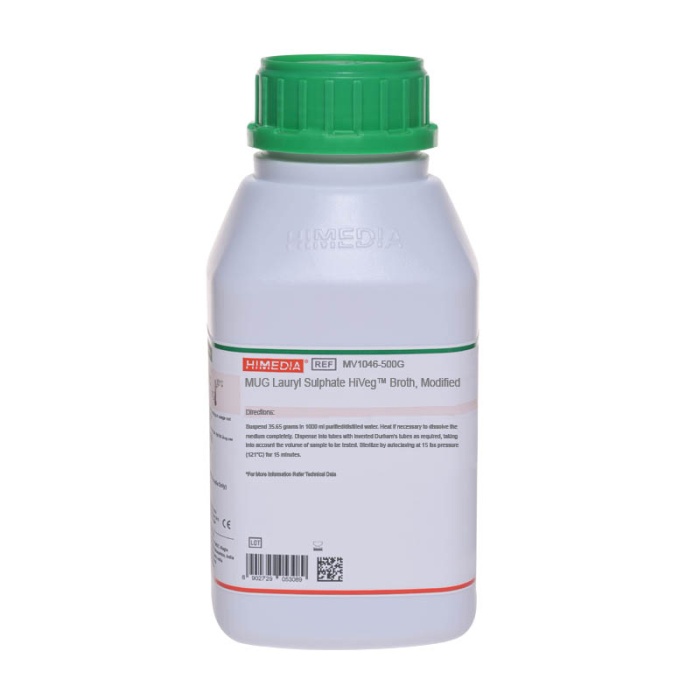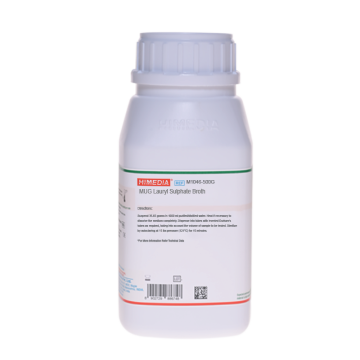 Your enquiry has been submitted
Your enquiry has been submitted
MUG Lauryl Sulphate Broth, Modified
Intended Use
Recommended as a selective medium for enumeration of presumptive Escherichia coli and other coliforms from milk and milk products. The composition and performance criteria of this medium are as per the specifications laid down in ISO 11866-2:2005.
Composition**
| Ingredients | g/L |
|---|---|
| Tryptone | 20.000 |
| Lactose | 5.000 |
| Sodium chloride | 5.000 |
| Dipotassium hydrogen phosphate | 2.750 |
| Monopotassium phosphate | 2.750 |
| Sodium lauryl sulphate | 0.100 |
| 4-Methylumbelliferyl ß-D-glucuronide (MUG) | 0.050 |
| Tryptophan | 1.000 |
Final pH (at 25°C): 6.8±0.2
**Formula adjusted, standardized to suit performance parameters
Directions
Suspend 36.7 grams in 1000 ml purified/distilled water. Heat if necessary to dissolve the medium completely. Dispense into tubes with inverted Durham's tubes as required, taking into account the volume of the samples to be tested. Sterilize by autoclaving at 15 lbs pressure (121°C) for 15 minutes.
Principle And Interpretation
The coliform group consists of several genera of bacteria belonging to the family Enterobacteriaceae. Lauryl Sulphate Broth formulated by Mallmann and Darby (1) is recommended by APHA for the detection and enumeration of coliform organisms in foods, water and waste water (2, 3). MUG is added in Lauryl Sulphate Broth as the fluorogenic compound which permits the rapid detection of Escherichia coli when observed under UV light where further confirmation is not required (2, 4). MUG Lauryl Sulphate Broth, Modified is recommended by the ISO Committee (5) for enumeration of presumptive E.coli and other coliforms from milk and milk products.
E.coli possesses the enzyme beta-glucuronidase and is capable of cleaving the fluorogenic substrate 4-Methylumbelliferyl beta-D-glucuronide (MUG) with the corresponding release of the fluorogen.
MUG detects anaerogenic strains, which may not be detected in the conventional procedure. Feng and Hartman (6) used MUG-containing medium for studying beta-glucuronidase activity and found that E.coli has 96-100% activity, while Salmonella species has 17% and Shigella species 40% activity and other genera were negative. For weakly positive strains, incubation should be carried out overnight. Robison (4) achieved no false negative results and about 5% false positive results. Tryptone provides nutrients while lactose acts as energy source. Sodium lauryl sulphate inhibits many organisms other than coliforms. 4-methylumbelliferyl- beta -D-glucuronide is hydrolyzed by the enzyme beta-glucuronidase to yield 4- methylumbelliferone, a fluorescent end product.
Inoculate 10 ml of the test specimen into three tubes each of single strength and double strength. Incubate the tubes at 35°C for 24 hours. Observe for opacity and gas formation. For confirmation of presumptive E.coli, observe for fluorescence and perform indole reaction using Kovacs Reagent (R008) (6).
Type of specimen
Food and dairy samples; Water samples
Specimen Collection and Handling
For food and dairy samples, follow appropriate techniques for sample collection and processing as per guidelines (2,7,8). For water samples, follow appropriate techniques for sample collection, processing as per guidelines and local standards (3). After use, contaminated materials must be sterilized by autoclaving before discarding.
Warning and Precautions :
Read the label before opening the container. Wear protective gloves/protective clothing/eye protection/ face protection. Follow good microbiological lab practices while handling specimens and culture. Standard precautions as per established guidleines should be followed while handling specimens. Saftey guidelines may be referred in individual safety data sheets
Limitations :
This medium is general purpose medium and may not support the growth of fastidious organisms.
Performance and Evaluation
Performance of the medium is expected when used as per the direction on the label within the expiry period when stored at recommended temperature.
Quality Control
Appearance Cream to yellow homogeneous free flowing powder
Colour and Clarity of prepared medium Light amber coloured clear solution without any precipitate
Reaction Reaction of 3.67% w/v aqueous solution at 25°C. pH : 6.8±0.2
pH 6.60-7.00
Cultural Response Cultural characteristics observed after an incubation at 30°C for 24 hours.
| Organism | Inoculum (CFU) | Growth | Fluorescence under uv at 366nm | Indole production |
|---|---|---|---|---|
| Escherichia coli ATCC 25922 (00013*) | 50-100 | luxuriant | positive | positive reaction, red ring at the interface of the medium |
| # Klebsiella aerogenes ATCC 13048 (00175*) | 50-100 | luxuriant | negative | negative reaction |
Key: *Corresponding WDCM numbers. # Formerly known as Enterobacter aerogenes
Storage and Shelf Life
Store between 10-30°C in a tightly closed container and the prepared medium at 2-8°C. Use before expiry date on the label. On opening, product should be properly stored dry, after tightly capping the bottle inorder to prevent lump formation due to the hygroscopic nature of the product. Improper storage of the product may lead to lump formation. Store in dry ventilated area protected from extremes of temperature and sources of ignition Seal the container tightly after use. Use before expiry date on the label. Product performance is best if used within stated expiry period.
Disposal
User must ensure safe disposal by autoclaving and/or incineration of used or unusable preparations of this product. Follow established laboratory procedures in disposing of infectious materials and material that comes into contact with sample must be decontaminated and disposed of in accordance with current laboratory techniques (9,10).
Reference
- Mallmann and Darby, 1941, Am.J. Public Health, 31:127.
- Salfinger Y., and Tortorello M.L., 2015, Compendium of Methods for the Microbiological Examination of Foods, 5th Ed., American Public Health Association, Washington, D.C.
- Lipps WC, Braun-Howland EB, Baxter TE, eds. Standard methods for the Examination of Water and Wastewater, 24th ed. Washington DC:APHA Press; 2023.
- Robison, 1984, Appl.Environ.Microbiol., 48:285.
- International Organization for Standardization (ISO) Milk and milk products -- Enumeration of presumptive Escherichia coli -- Part 2: Most probable number technique using 4-methylumbelliferyl-beta-D-glucuronide (MUG), ISO 11866-2-1997
- Feng P.C.S. and Hartman P. A., 1982, Appl. Environ. Microbiol., 43:1320.
- American Public Health Association, Standard Methods for the Examination of Dairy Products, 1978, 14th Ed., Washington D.C.
- Wehr H. M. and Frank J. H., 2004, Standard Methods for the Microbiological Examination of Dairy Products, 17th Ed., APHA Inc., Washington, D.C.
- Isenberg, H.D. Clinical Microbiology Procedures Handbook 2nd Edition.
- Jorgensen, J.H., Pfaller, M.A., Carroll, K.C., Funke, G., Landry, M.L., Richter, S.S and Warnock., D.W. (2015) Manual of Clinical Microbiology, 11th Edition. Vol. 1
| Product Name | MUG Lauryl Sulphate Broth, Modified |
|---|---|
| SKU | M1046I |
| Product Type | Regular |
| Physical Form | Powder |
| Origin | Animal |
| Packaging type | HDPE |
| References | 1. Mallmann and Darby, 1941, Am.J. Public Health, 31:127. |
| Customized Product Available | No |









